Business Continuity and Disaster Recovery Plan: A Detailed Report
VerifiedAdded on 2020/04/15
|5
|807
|47
Report
AI Summary
This report delves into the critical aspects of a Business Continuity Plan and Disaster Recovery Plan, emphasizing the importance of organizational reputation and the potential impact of law enforcement involvement. It explores the dynamics of dispute resolution, highlighting the preference for negotiation and alternative methods like arbitration to mitigate reputational damage. The report discusses how organizations can proactively manage disputes, focusing on policies that prevent negative publicity and maintain ethical standards. It details the negotiation process, including the role of mediators and arbitrators in resolving conflicts, ensuring confidentiality, and reaching mutually agreeable solutions. The conclusion underscores the value of resolving disputes outside of legal channels to preserve goodwill and uphold ethical practices within the business environment.
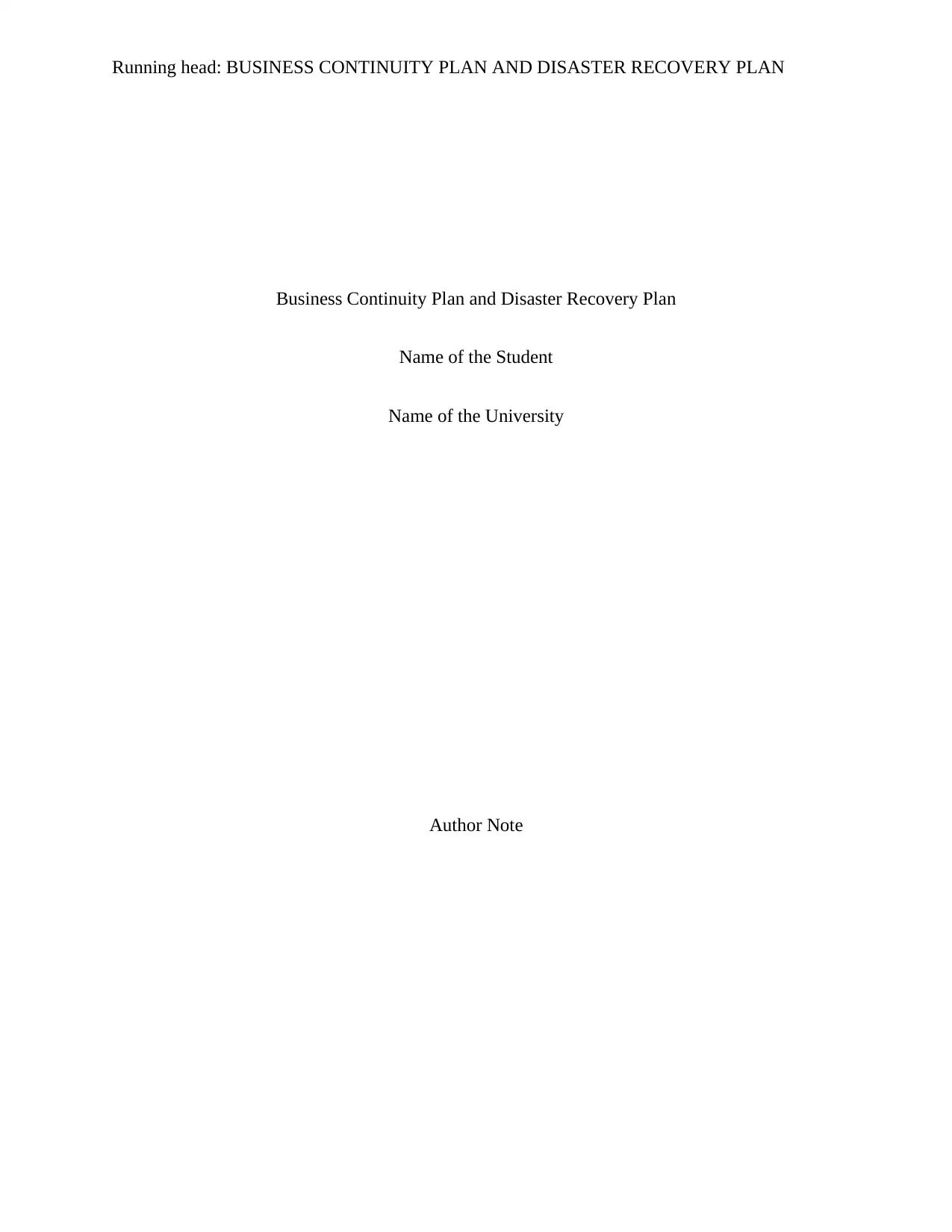
Running head: BUSINESS CONTINUITY PLAN AND DISASTER RECOVERY PLAN
Business Continuity Plan and Disaster Recovery Plan
Name of the Student
Name of the University
Author Note
Business Continuity Plan and Disaster Recovery Plan
Name of the Student
Name of the University
Author Note
Paraphrase This Document
Need a fresh take? Get an instant paraphrase of this document with our AI Paraphraser
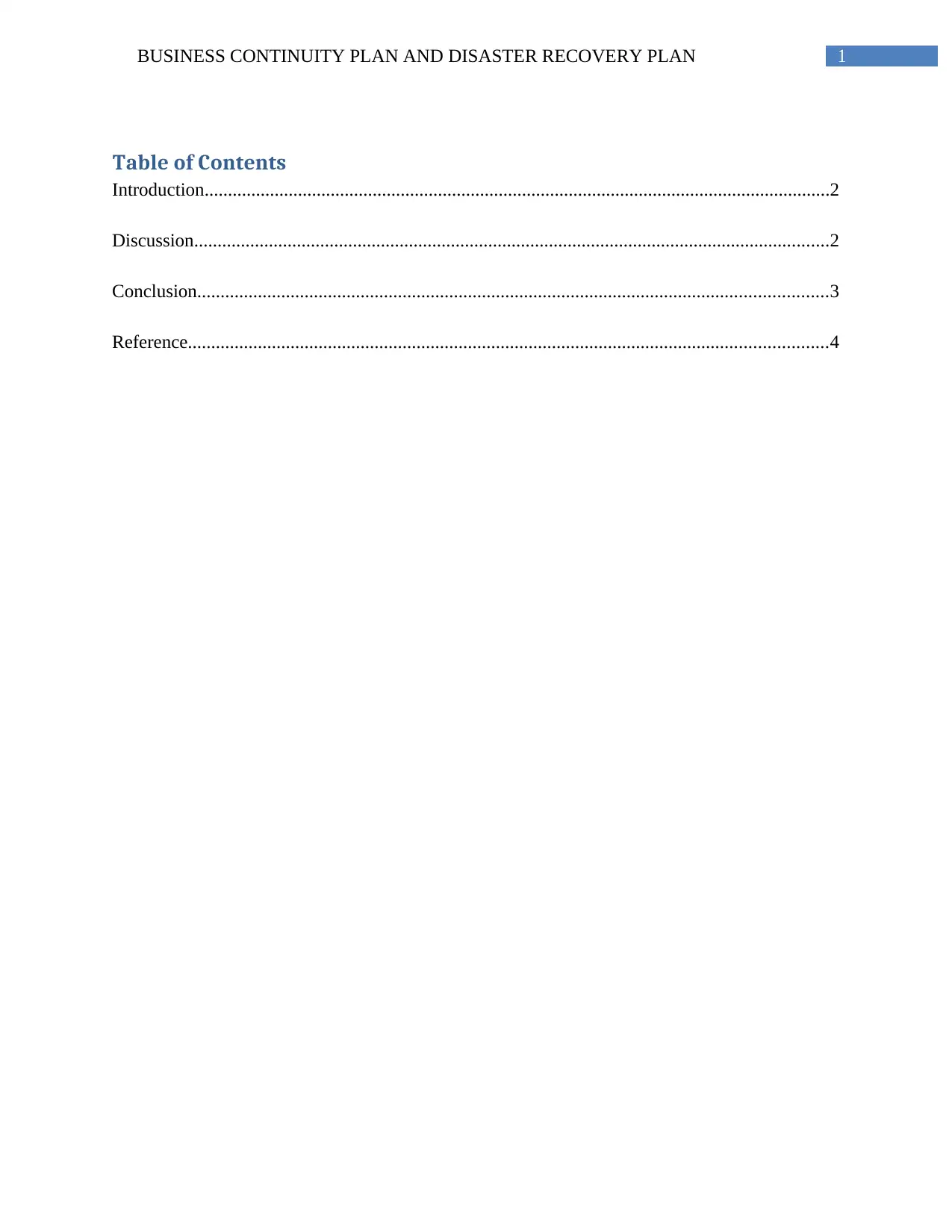
1BUSINESS CONTINUITY PLAN AND DISASTER RECOVERY PLAN
Table of Contents
Introduction......................................................................................................................................2
Discussion........................................................................................................................................2
Conclusion.......................................................................................................................................3
Reference.........................................................................................................................................4
Table of Contents
Introduction......................................................................................................................................2
Discussion........................................................................................................................................2
Conclusion.......................................................................................................................................3
Reference.........................................................................................................................................4
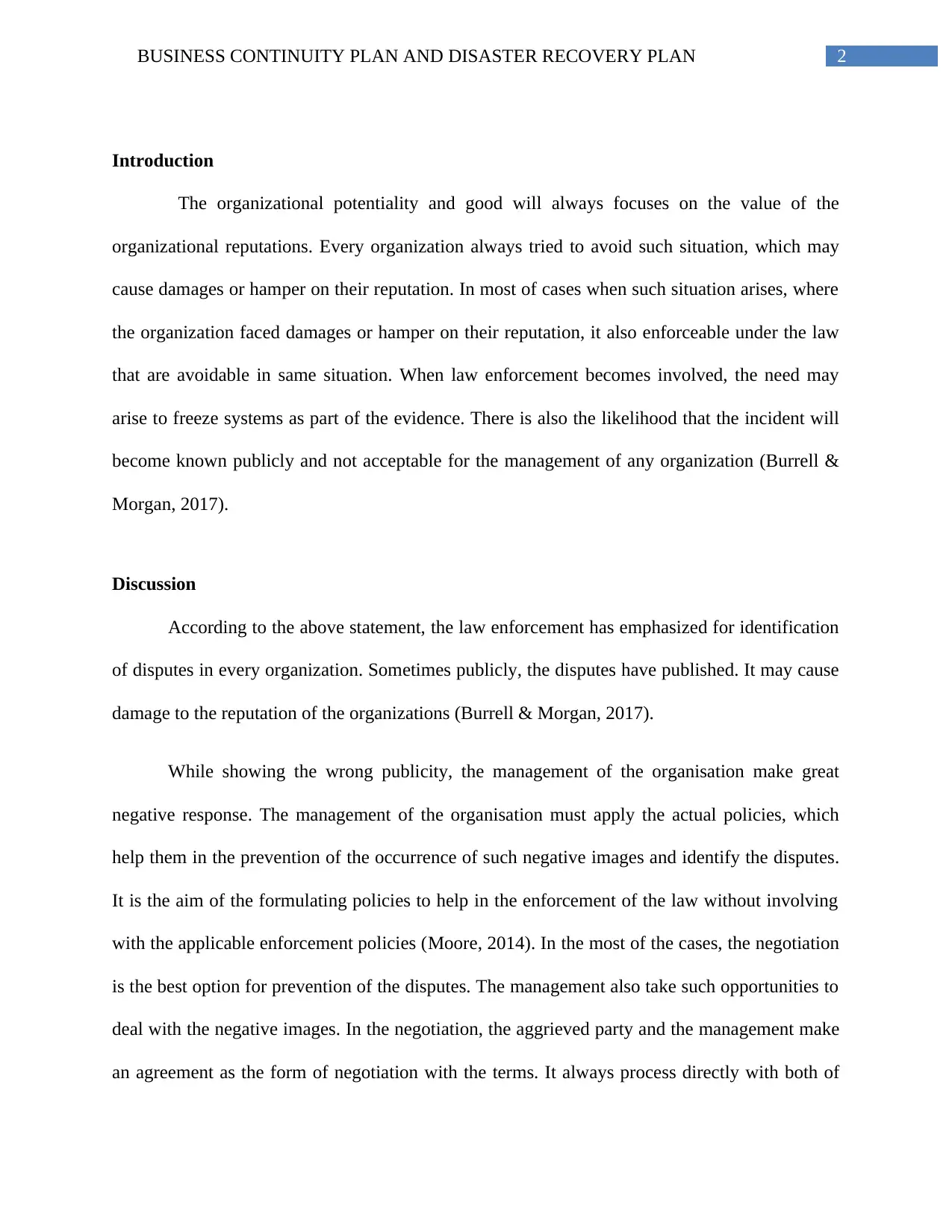
2BUSINESS CONTINUITY PLAN AND DISASTER RECOVERY PLAN
Introduction
The organizational potentiality and good will always focuses on the value of the
organizational reputations. Every organization always tried to avoid such situation, which may
cause damages or hamper on their reputation. In most of cases when such situation arises, where
the organization faced damages or hamper on their reputation, it also enforceable under the law
that are avoidable in same situation. When law enforcement becomes involved, the need may
arise to freeze systems as part of the evidence. There is also the likelihood that the incident will
become known publicly and not acceptable for the management of any organization (Burrell &
Morgan, 2017).
Discussion
According to the above statement, the law enforcement has emphasized for identification
of disputes in every organization. Sometimes publicly, the disputes have published. It may cause
damage to the reputation of the organizations (Burrell & Morgan, 2017).
While showing the wrong publicity, the management of the organisation make great
negative response. The management of the organisation must apply the actual policies, which
help them in the prevention of the occurrence of such negative images and identify the disputes.
It is the aim of the formulating policies to help in the enforcement of the law without involving
with the applicable enforcement policies (Moore, 2014). In the most of the cases, the negotiation
is the best option for prevention of the disputes. The management also take such opportunities to
deal with the negative images. In the negotiation, the aggrieved party and the management make
an agreement as the form of negotiation with the terms. It always process directly with both of
Introduction
The organizational potentiality and good will always focuses on the value of the
organizational reputations. Every organization always tried to avoid such situation, which may
cause damages or hamper on their reputation. In most of cases when such situation arises, where
the organization faced damages or hamper on their reputation, it also enforceable under the law
that are avoidable in same situation. When law enforcement becomes involved, the need may
arise to freeze systems as part of the evidence. There is also the likelihood that the incident will
become known publicly and not acceptable for the management of any organization (Burrell &
Morgan, 2017).
Discussion
According to the above statement, the law enforcement has emphasized for identification
of disputes in every organization. Sometimes publicly, the disputes have published. It may cause
damage to the reputation of the organizations (Burrell & Morgan, 2017).
While showing the wrong publicity, the management of the organisation make great
negative response. The management of the organisation must apply the actual policies, which
help them in the prevention of the occurrence of such negative images and identify the disputes.
It is the aim of the formulating policies to help in the enforcement of the law without involving
with the applicable enforcement policies (Moore, 2014). In the most of the cases, the negotiation
is the best option for prevention of the disputes. The management also take such opportunities to
deal with the negative images. In the negotiation, the aggrieved party and the management make
an agreement as the form of negotiation with the terms. It always process directly with both of
⊘ This is a preview!⊘
Do you want full access?
Subscribe today to unlock all pages.

Trusted by 1+ million students worldwide
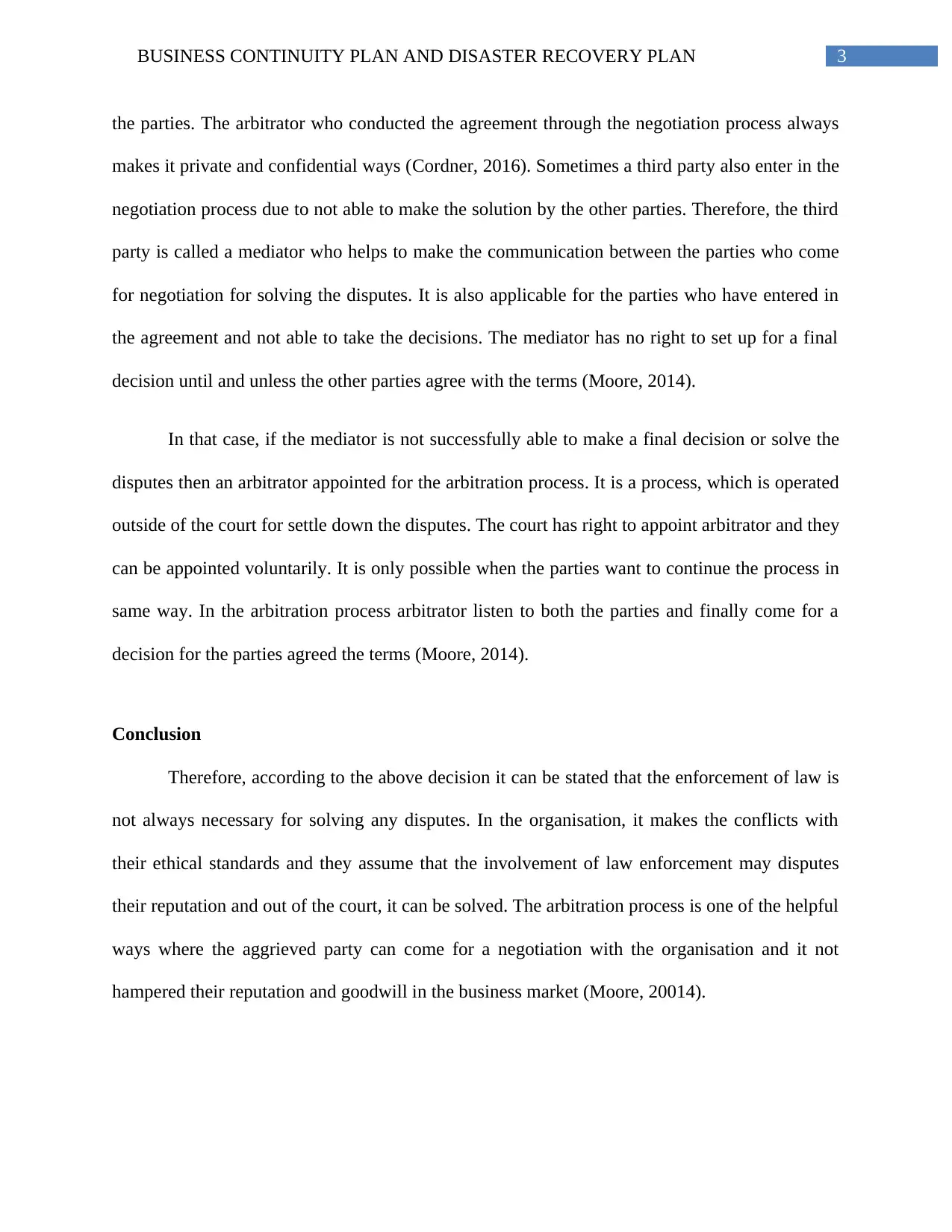
3BUSINESS CONTINUITY PLAN AND DISASTER RECOVERY PLAN
the parties. The arbitrator who conducted the agreement through the negotiation process always
makes it private and confidential ways (Cordner, 2016). Sometimes a third party also enter in the
negotiation process due to not able to make the solution by the other parties. Therefore, the third
party is called a mediator who helps to make the communication between the parties who come
for negotiation for solving the disputes. It is also applicable for the parties who have entered in
the agreement and not able to take the decisions. The mediator has no right to set up for a final
decision until and unless the other parties agree with the terms (Moore, 2014).
In that case, if the mediator is not successfully able to make a final decision or solve the
disputes then an arbitrator appointed for the arbitration process. It is a process, which is operated
outside of the court for settle down the disputes. The court has right to appoint arbitrator and they
can be appointed voluntarily. It is only possible when the parties want to continue the process in
same way. In the arbitration process arbitrator listen to both the parties and finally come for a
decision for the parties agreed the terms (Moore, 2014).
Conclusion
Therefore, according to the above decision it can be stated that the enforcement of law is
not always necessary for solving any disputes. In the organisation, it makes the conflicts with
their ethical standards and they assume that the involvement of law enforcement may disputes
their reputation and out of the court, it can be solved. The arbitration process is one of the helpful
ways where the aggrieved party can come for a negotiation with the organisation and it not
hampered their reputation and goodwill in the business market (Moore, 20014).
the parties. The arbitrator who conducted the agreement through the negotiation process always
makes it private and confidential ways (Cordner, 2016). Sometimes a third party also enter in the
negotiation process due to not able to make the solution by the other parties. Therefore, the third
party is called a mediator who helps to make the communication between the parties who come
for negotiation for solving the disputes. It is also applicable for the parties who have entered in
the agreement and not able to take the decisions. The mediator has no right to set up for a final
decision until and unless the other parties agree with the terms (Moore, 2014).
In that case, if the mediator is not successfully able to make a final decision or solve the
disputes then an arbitrator appointed for the arbitration process. It is a process, which is operated
outside of the court for settle down the disputes. The court has right to appoint arbitrator and they
can be appointed voluntarily. It is only possible when the parties want to continue the process in
same way. In the arbitration process arbitrator listen to both the parties and finally come for a
decision for the parties agreed the terms (Moore, 2014).
Conclusion
Therefore, according to the above decision it can be stated that the enforcement of law is
not always necessary for solving any disputes. In the organisation, it makes the conflicts with
their ethical standards and they assume that the involvement of law enforcement may disputes
their reputation and out of the court, it can be solved. The arbitration process is one of the helpful
ways where the aggrieved party can come for a negotiation with the organisation and it not
hampered their reputation and goodwill in the business market (Moore, 20014).
Paraphrase This Document
Need a fresh take? Get an instant paraphrase of this document with our AI Paraphraser
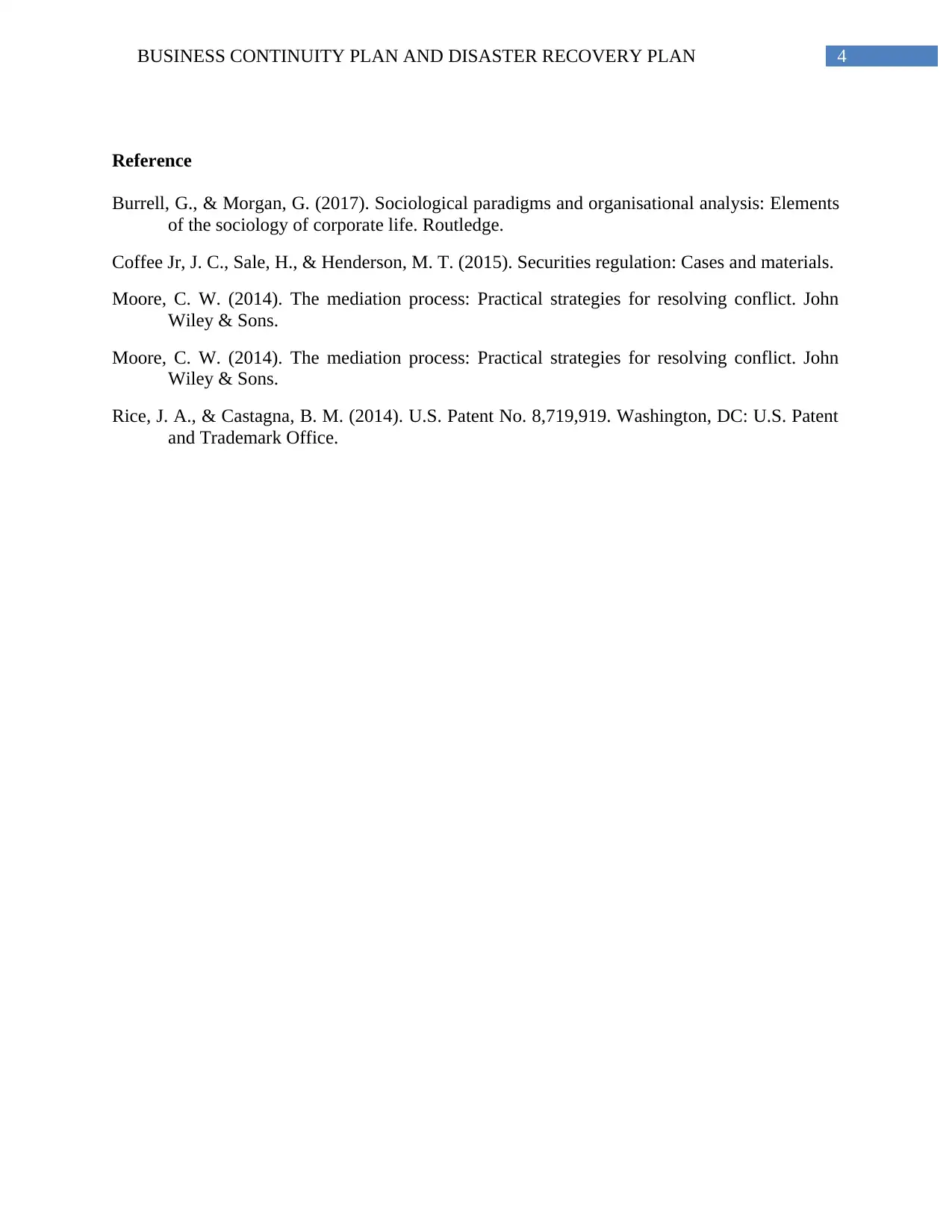
4BUSINESS CONTINUITY PLAN AND DISASTER RECOVERY PLAN
Reference
Burrell, G., & Morgan, G. (2017). Sociological paradigms and organisational analysis: Elements
of the sociology of corporate life. Routledge.
Coffee Jr, J. C., Sale, H., & Henderson, M. T. (2015). Securities regulation: Cases and materials.
Moore, C. W. (2014). The mediation process: Practical strategies for resolving conflict. John
Wiley & Sons.
Moore, C. W. (2014). The mediation process: Practical strategies for resolving conflict. John
Wiley & Sons.
Rice, J. A., & Castagna, B. M. (2014). U.S. Patent No. 8,719,919. Washington, DC: U.S. Patent
and Trademark Office.
Reference
Burrell, G., & Morgan, G. (2017). Sociological paradigms and organisational analysis: Elements
of the sociology of corporate life. Routledge.
Coffee Jr, J. C., Sale, H., & Henderson, M. T. (2015). Securities regulation: Cases and materials.
Moore, C. W. (2014). The mediation process: Practical strategies for resolving conflict. John
Wiley & Sons.
Moore, C. W. (2014). The mediation process: Practical strategies for resolving conflict. John
Wiley & Sons.
Rice, J. A., & Castagna, B. M. (2014). U.S. Patent No. 8,719,919. Washington, DC: U.S. Patent
and Trademark Office.
1 out of 5
Related Documents
Your All-in-One AI-Powered Toolkit for Academic Success.
+13062052269
info@desklib.com
Available 24*7 on WhatsApp / Email
![[object Object]](/_next/static/media/star-bottom.7253800d.svg)
Unlock your academic potential
Copyright © 2020–2025 A2Z Services. All Rights Reserved. Developed and managed by ZUCOL.



